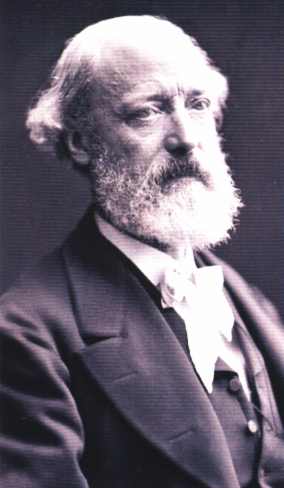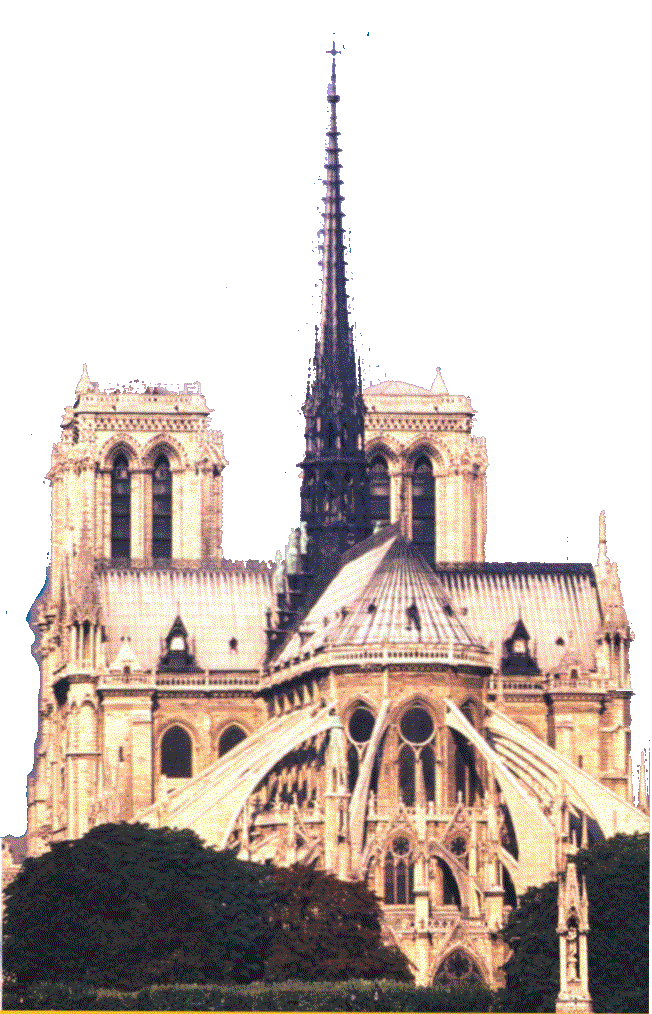Article from FranceGuide 2003
MASTER RE-BUILDER
BY JULIE LASKY
 |
 |
CLOUD-PIERCING SPIRES, crenellated turrets, jeweled windows, flying buttresses—these are the entice¬ments of France's most beloved landmarks. Each year, hundreds of thousands of tourists admire the cone-capped towers surrounding the fortress at Carcassonne and squint at the gargoyles leering from the façade of Notre-Dame in Paris. And, yet, some of France's seeming vestiges of medieval times are younger than the steam engine. They are the work of Eugène Emmanuel Viollet-le-Duc (b. Paris 1814, d. Lausanne 1879), the controversial architect who restored many of France's Gothic buildings. There is no question that Viollet is key to our vision of how medieval France looked: A self-taught architect with a passion for the Gothic style, Viollet resurrected its muscular forms everywhere, from the ramparts of Avignon's papal palace to Château de Pierrefonds.
Gothic architecture was born in the Ile-de-France in the 12th century, but by Viollet's time much of it was in ruins. The French Revolution's anticlerical and aristocracy-bashing habits contributed to the erosion. And even when it survived intact, the style had lost its appeal. "People saw it as deranged contortions in stone," says Michael Lewis, a professor of art history at Williams College, in Williamstown, Massachusetts, referring to lacy nests of arches and finials knobbed like brussels sprouts. Viollet demonstrated rational thought behind every fanciful detail, helping to launch the Gothic Revival movement that swept the rest of 19th-century Europe and America. "He gave us an understanding of the Gothic as a structural system," Lewis says. "He revered its intelligence."
The architect was fortunate to launch his practice at a time when France was investing heavily in renewal. In 1836, Prosper Mérimée, France's inspector of historical monuments (and author of Carmen), consecrated 12th-century Gothic wall frescos at St-Savin as one of the nation's first Monuments Historiques. And Victor Hugo's popular novels of medieval Paris, notably The Hunchback of Notre-Dame (1831), did much to romanticize the Gothic.
Viollet began his work in 1840 with the Basilique Ste-Madeleine in Vézelay, a Romanesque building dating from the 12th century that was so badly neglected that mature trees sprouted from its masonry. By 1853, Viollet had been named inspector general for crumbling churches from Marseille to Strasbourg. Although Viollet did have copious historical records from which to work, including drawings, paintings, and engravings that revealed the look of medieval France, his ability to extrapolate is what defined his talent. "The statement that there wasn't a cathedral in France not remade by Viollet-le-Duc is an exaggeration," says Columbia University art historian Barry Bergdoll. But not much of one, he adds.
His career highlights include his work on the cathedrals at Narbonne, Amiens, Troyes, Reims, St-Michel, Clermont-Ferrand, Beauvais, Béziers, and Evreux. If there is a work of French Gothic architecture that Viollet did not restore in his lifetime, chances are good that a disciple of his did. He wrote as prolifically as he pre-served, turning out dozens of treatises on the finer points of arcs doubleaux (a type of intersecting roof bracings), stained glass, and armor. Begun in 1845, his 19-year restoration of Notre-Dame in Paris alone was a training ground for a generation of preservationists.
Any doubt about Viollet lies in his methods. As the art of preservation took root in the 19th century, its practitioners debated how to treat a building's damaged or missing parts. Viollet's answer was simple: He let research and imagination fill in the gaps. He didn't hesitate to replace the world's first flying buttresses at Notre-Dame with more efficient, modern ones. And after finding evidence that Pierrefonds's interiors had been painted in colorful designs, long vanished, he simply created his own. He put together whole, usable buildings that fulfilled what he believed were their originators' intentions. "The goal of restoring a monument," he famously wrote, "is not to preserve it, to repair it, or rebuild it; it is to reinstate it in a condition of complete¬ness that could never have existed at any time."
This proclamation was heretical to many of his contemporaries. In England, where medieval ruins drove poets into creative fits of melancholy, the 19th-century English art historian John Ruskin argued for the value of every broken stone. "Restoration," Ruskin insisted, "means the most total destruction that a building can suffer." After visiting Carcassonne, Henry James wrote, "For myself, I have no hesitation; I prefer in every case the ruined, however ruined, to the reconstructed, however splendid. What is left is more precious than what is added: The one is history, the other fiction."
Of course, Viollet did more than just spruce up buildings. Long after his death, his critics still carped that, among other offenses, he foisted a 13th-century façade onto the 14th-century cathedral at Clermont-Ferrand, turned Pierrefonds into a cliché of a medieval castle, and exaggerated the peaks of Carcassonne's towers (he was also charged with using the wrong roof tiles). And still, James con¬cluded, "the restoration of Carcassonne is a splendid achievement – a city in a fairy tale."
After a major Viollet retrospective in 1980 at the Grand Palais in Paris, many more of Viollet's critics became converts. Had he gotten the Middle Ages right after all? Are modern preservationists coming around to his way of thinking? Neither, art historians say. What has changed is an appreciation of how Viollet served both history and progress. His research and problem-solving skills paid tribute to his own age of exploration as well as to the period he revived.
His methods, which required sensitive artistic decisions, would
be hard to duplicate because they are beyond the scope of most architects.
"Historic preservation today dictates that you save everything," art
historian Michael Lewis says. "But if a cornice was leaking, Viollet-le-Duc
reasoned that it would have been replaced by the original archi¬tect. His
principle was, `Don't shackle yourself to the physical evidence."' It is
a far cry from today's cookie-cutter practice, Lewis adds, a method he calls
"restoration for morons."
Château de Roquetaillade, Mazères
Original construction: 1306; second restoration: begun in 1866
In 1306, Cardinal de la Mothe, a nephew of Pope Clement V, the first pope to
move to Avignon, began construction of what was then deemed the “new”
château (previous fortifications on the site were prehistoric).
The château has remained in the same family – and been lived in
– for 700 year s. Viollet was hired to oversee the repair and restoration
of the stonework, as well as to fashion luxurious interiors. Viollet designed
all of the furniture, decorative details, floor tile, and stairways.
